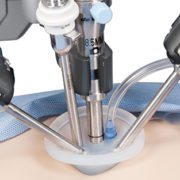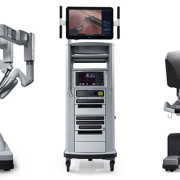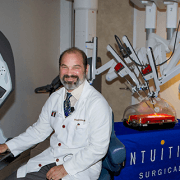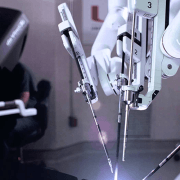Single-Site Surgery… Performing Complex Surgery Through a 1-inch Incision!
Another First for Tomball Regional Medical Center
As proven leaders in robotic surgery, Tomball Regional Medical Center and Dr. Brian Harkins has accomplished yet another milestone!!! Single-Site surgery on the Da Vinci Xi robot premiered at TRMC on May 4, 2016. Dr. Harkins accomplished the first Single-Site cholecystectomy on the Xi in Houston… in Texas… and one of the first ten in the country.
The FDA recently released approval for the technology to be applied to the Xi platform which allows gallbladder surgery to be done through a single one-inch incision at the umbilicus. Currently, the approved surgeries are Cholecystectomy, Oophorectomy, and Hysterectomy. As experience grows and technological advances continue, expect more and more surgery to be done through ever decreasing incisions!
While one could expect to pay a premium for this state of the art technology the reality is that the cost is ever less than the robotic multiport equivalent. Dr. Harkins is currently seeking patients to assess if they are candidates for Single-Site on the DaVinci Xi. In fact, as of press time for this newsletter, it’s the only place you can get in Houston!
Houston Technology Turns Hard to Easy… and Safe
Some of you may recognize the term Single Site or Single Port. The concerted effort to introduce this approach into laparoscopy began in 2007. Studies proved it safe and effective. The increased degree of difficulty in doing the operation, however, resulted in limited penetration into the field of surgery.
Placing 3 instruments and a camera through once trocar and trying to find enough room to manipulate all of that in close quarters was challenging at best. Not to mention that the limited working room required the instrument on the left of the screen and visa-verse for the other hand. It was kind of like operating looking into a mirror while playing Twister! No wonder it didn’t catch on as expected. But if you connect all the instrument to the robotic platform then Presto… hard becomes easy.
The robot is designed to manage the tight quarters and the computer adjusts the view for the unnatural angles and visual associations. The older model DaVinci Si was the first robotic platform to have this but many surgeons had limited access to a robot making that the rate limiting step for adoption. Robots are increasingly more available and general surgeons are quickly adopting the platform. Couple this with added safety in identifying the ductal anatomy using Firefly visualization (see side panel) and it’s easy to see how the future of minimally invasive surgery is the header in “1” direction. 1 incision, 1 inch long equals 1 happy patient!
“Fly” thru the abdominal cavity, please click here
Dr. Harkins Guest Lectures in Minneapolis
“One of the aspects I like the most about being on the cutting edge of technology in surgery is the ability to interact with colleagues across the country as the surgical community helps to shape this emerging standard” stated Dr. Brian Harkins in a recent lecture to surgeon colleagues in Minneapolis, Minnesota. He pointed out that the surgical community has seen this happen before.
The early 1990’s saw the emergence of laparoscopy as a standard practice in general surgery. Most laparoscopy prior to that was performed by gynecology. In less than a decade, laparoscopy became a gold standard in many procedures and general surgeons became the most prolific laparoscopists.
While urology and gynecology have lead the way in robotics since 2000, it’s the new advanced technologies and latest robotic platform, the Xi, that have opened the door for general surgery to perform an increasing number of complex multi-quadrant procedures. He concluded, “This is paving the way for robotic surgery to be the new minimally invasive standard in general surgery. You could say, its laparoscopy with a long overdue upgrade to advance technology!”
Dr. Harkins is recognized as a world leader in experience using the Da Vinci Xi system in General Surgery.











